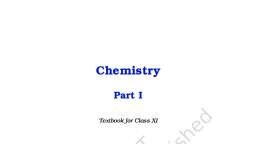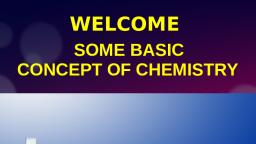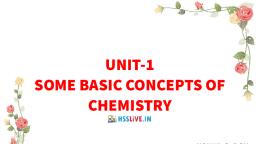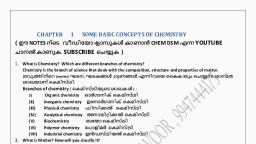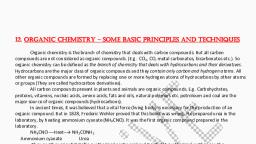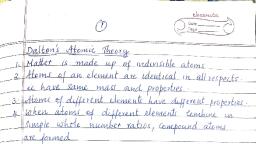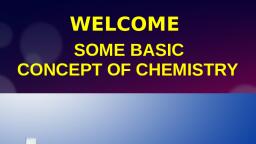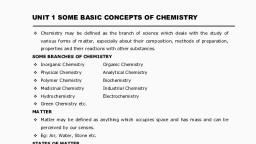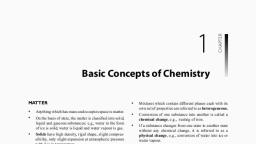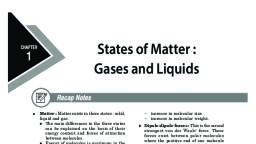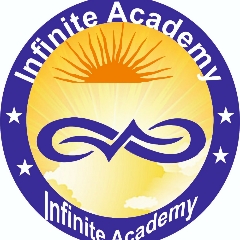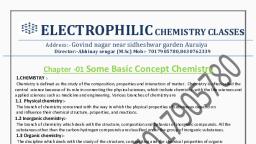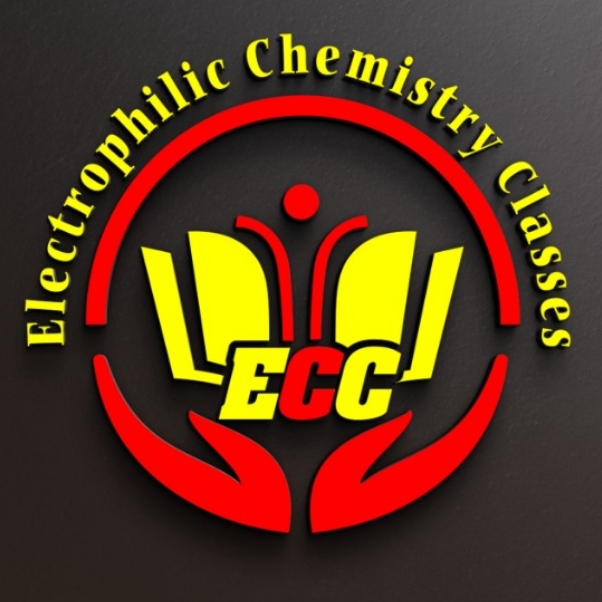Page 1 :
UNIT-1, SOME BASIC CONCEPTS, OF CHEMISTRY
Page 2 :
Chemistry, The branch of science which deals, with the composition, structure and, , properties, , of, , matter, , and, , the, , changes which matter undergoes., , Shyja nair R K.NHSS Nellimoodu, , 2
Page 3 :
Branches of Chemistry, , Medicinal Chemistry, , Inorganic Chemistry, , ✔, , Organic Chemistry, , ✔, , Physical Chemistry, , ✔, , Analytical Chemistry, , ✔, , Polymer Chemistry, , ✔, , Biochemistry, , ✔, , ✔, , ✔, , ✔, , ✔, , ✔, , ✔, , Industrial Chemistry, , Hydrochemistry, Electrochemistry, Green Chemistry, Pharmaceutical Chemistry, , Shyja nair R K.NHSS Nellimoodu, , 3
Page 4 :
MATTER, Anything which occupies space and, , has mass and can be perceived by, our senses., , Eg: Air, Water, Stone etc., , Shyja nair R K.NHSS Nellimoodu, , 4
Page 8 :
Solids, Have definite mass, volume and shape., The constituent particles are tightly, packed Intermolecular distances are, , short., Intermolecular forces are strong., Constituent particles have fixed, positions., They can only oscillate about their mean, , positions. Incompressible, and rigid., Shyja nair R K.NHSS Nellimoodu, , 8
Page 9 :
Liquids, Liquids have definite volume. They do not, have a definite shape., They take the shape of the container in which they, , are placed., The constituent particles are loosely packed., The, , intermolecular, , distances, , will, , be, , large, , as, , compared to that of solids., Intermolecular forces are weak compared to solids., Shyja nair R K.NHSS Nellimoodu, , 9
Page 10 :
Gases, Gases have neither definite shape nor definite, volume. The particles are far apart ., The intermolecular distances are very large., The intermolecular forces of attraction are very, weak. Gases are highly compressible., Gases exert pressure equally in all directions., , Shyja nair R K.NHSS Nellimoodu, , 10
Page 15 :
-ELEMENTS, An element is a pure substance., It cannot be broken down into two or more, simpler substances by physical and chemical, means., It is made up of only one kind of particles-atoms, or molecules, Eg: Copper, Silver, Gold, hydrogen ,Oxygen etc.., , Shyja nair R K.NHSS Nellimoodu, , 15
Page 19 :
MIXTURES, A mixture is made up of two or more, , substances present in it in any, ratio.They are of two typesHomogeneous and Heterogeneous, Eg: Brass ,Air,Salt solution etc ., Shyja nair R K.NHSS Nellimoodu, , 19
Page 20 :
HOMOGENEOUS MIXTURE, , Mixtures having uniform, composition throughout are, called homogeneous mixtures, Eg: Ethanol – Water mixture, Salt solution, sugar solution etc., Shyja nair R K.NHSS Nellimoodu, , 20
Page 22 :
HETEROGENEOUS MIXTURE, The constituent particles are not uniformly, mixed., The, , properties, , and, , composition, , vary, , throughout the mixture., Eg: Gun powder is a mixture of charcoal,, , sulphur and nitre., Muddy water, Chalk powder in water etc., Shyja nair R K.NHSS Nellimoodu, , 22
Page 27 :
MASS, , Mass, , of, , a substance, , is the, , amount, , of, , matter present in it., The mass of a substance is constant., The SI unit of mass is kg., , Shyja nair R K.NHSS Nellimoodu, , 27
Page 28 :
WEIGHT, , Weight is the force exerted by gravity on, an object., Weight may vary from one place to, , another due to change in gravity., , Shyja nair R K.NHSS Nellimoodu, , 28
Page 29 :
DENSITY, Density of a substance is the amount of, mass per unit volume., , The SI unit of density is kg/m3, other unit -gm/cm3, , Shyja nair R K.NHSS Nellimoodu, , 29
Page 30 :
TEMPERATURE, Temperature is the degree of hotness of a, body., Three, , common, , scales, , are, , used, , to, , measure temperature., Degree Celsius (0C), Degree Fahrenheit (0F), Kelvin (K)., Shyja nair R K.NHSS Nellimoodu, , 30
Page 31 :
The Celsius scale is represented, , between zero, , degree to hundred degree Celsius., Fahrenheit scale is represented between 32, , 0, , to, , 2120 F., The Fahrenheit scale is related to Celsius scale as, follows, , The Kelvin scale is related to Celsius scale as, follows, , K = 0 C + 273.15, Shyja nair R K.NHSS Nellimoodu, , 31
Page 32 :
ACURACY & PRECISION, ACCURACY is the agreement of a particular, value to the true value of the result., PRECISION is the closeness of various, measurements for the same quantity., Eg: If the true value for a result is 2.00 g and three, student ‘A’ ,B and C takes two measurements each, Shyja nair R K.NHSS Nellimoodu, , 32
Page 33 :
Student A is precise but not accurate, Student B is neither precise nor accurate, Student C is precise and accurate, Shyja nair R K.NHSS Nellimoodu, , 33
Page 35 :
SIGNIFICANT FIGURES, , Significant figures are meaningful, digits which are known with, certainty.
Page 36 :
RULES FOR DETERMINING SIGNIFICANT FIGURES, , 1.All non zero digits are, significant. Eg: 235 has 3, significant figures., 2.Zero’s to the left of the first non zero digit, are not significant., , Eg: 0.002 has only one significant figure., Shyja nair R K.NHSS Nellimoodu, , 36
Page 37 :
3.Zero’s between non zero digits are, significant. Eg: 3.02 has 3 significant, , figures., 4.Zero’s to the right of the decimal, , point are significant., Eg: 2.00 has 3 significant figures, Shyja nair R K.NHSS Nellimoodu, , 37
Page 38 :
5.Zero at the end of a number is significant, only if they are on right side of decimal, point, , 5000 has 1 significant figure, 0.2000 has 4 significant figures, 1.0x 103 has 2 significant figures, 6.Counting numbers of objects have, infinite significant numbers, ‘3 apples’ has α significant figures, 3 =3.0 or 3.00 or 3.0000 etc, Shyja nair R K.NHSS Nellimoodu, , 38
Page 40 :
LAW OF CONSERVATION OF MASS, Matter can neither be created, nor be destroyed., , Eg: 12g carbon combines, with 32g oxygen to, , 44gCO2., , form, , Herethetotal, , mass of the reactants is, equal to the total mass, is, of the products., , Shyja nair R K.NHSS Nellimoodu, , Antoine Lavoisier, 40
Page 41 :
LAW OF DEFINITE PROPORTION, The same compound always contain the, same elements combined in the same, fixed proportion by mass., , Eg: NaCl may be obtained from sea, water., , It, , chemical, , is, , also, , prepared, , by, , reactions between NaOH, , and HCl. These samples on analysis, are found, , Joseph Proust, , to contain Na and Cl in, , thenair, ratio, Shyja, R K.NHSS23:35.5, Nellimoodu, , by mass., , 41
Page 42 :
LAW OF MULTIPLE PROPORTION, Whentwo elements combines to form more, , than one compound,the different masses of, one of the elements which combines with a, fixed mass of the other element are in the, ratio of simple whole numbers., , John Dalton, Shyja nair R K.NHSS Nellimoodu, , 42
Page 43 :
Hydrogen + Oxygen → Water, 2g, 16g, 18g, Hydrogen, Oxygen → Water, Hydrogen, + +Oxygen, →, Hydrogen, Peroxide, 2g, 16g, 2g Hydrogen +18g32g, 34g, Oxygen → Hydrogen Peroxide, 2g, 32g, the masses of oxygen, (i.e., 16 g and 32 g), 34g, the masses of oxygen (i.e. 16 g and 32 g), which combine, with, a fixed, which combine with, a fixed mass, of hydrogenmass of, (2g) bear a simple ratio, i.e. 16:32 or 1: 2., hydrogen(2g) bear a simple ratio, i.e., 16:32 or 1: 2., Shyja nair R K.NHSS Nellimoodu, , 43
Page 44 :
Eg:Carbon combines with, oxygen to form two different, oxides CO and CO2 ., In CO2, 12 g of carbon, combines with 32 g of oxygen, In CO ,12 g carbon combines, with 16g of oxygen., In these two cases, the mass, of oxygen combining with the, fixed mass of carbon are in the, ratio 16:32 or 1:2., Shyja nair R K.NHSS Nellimoodu, , 44
Page 45 :
GAY LUSSAC'S LAW, when gases combine to form gaseous products, a, simple, , ratio, , exists, , between, , the, , volumes, , of, , the, , reactants and the products at constant temperature, and pressure., , Eg: When H and Cl combine to, form HCl, a simple ratio by, volume exists between the gases, H2, Cl2 and HCl at constant, temperature and pressure., Shyja nair R K.NHSS Nellimoodu, , 45, , John Louis Gay Lussac
Page 46 :
AVOGADRO'S LAW, Equal volume of all gases under the, same conditions of temperature, and pressure contains the same, number of molecules., , Avogadro
Page 47 :
DALTON'S ATOMIC THEORY, 1. Matter is made up of small indivisible, particles called atoms., 2. Atoms of the same element are identical in, mass and other properties., 3. Atoms of different elements are different in, , mass and other properties., 4. Atoms can neither be created nor be, destroyed., , 5.Atoms combine in small whole numbers to, Shyjaatoms, nair R K.NHSScalled, Nellimoodu molecules., form compound, , 47
Page 48 :
ATOMIC MASS, Atomic, , defined, , mass, , as, , of, , a, , an, , element, , number, , expresses how many times, , is, , which, the, , mass of one atom of the element is, greater than 1/12 th the mass of a, , carbon-12 atom., Shyja nair R K.NHSS Nellimoodu, , 48
Page 49 :
ATOMIC MASS UNIT, 1/12th the mass of one carbon- 12 atom is, called atomic mass unit(amu). amu is also, known as unified mass (u)., , 1 amu = 1.66056 x 10, , -24, , g, , In amu scale mass of one carbon atom = 12, amu, Mass of one hydrogen atom = 1.008 amu, Mass of one oxygen atom = 15.999 amu = 16, amu, Shyja nair R K.NHSS Nellimoodu, 49
Page 50 :
Atomic mass of many elements, have fractional value why?, Many naturally occurring elements exist as, more than one isotope. When we take into, account the existence of these isotopes and, their relative abundance and the average, atomic mass of that element can be computed, Chlorine has 2 isotopes Cl35 and Cl37 in the, ratio 3;1.So the average atomic mass of Cl, =(3x35 +1x37)/4 = 35.5, Shyja nair R K.NHSS Nellimoodu, , 50
Page 51 :
MOLECULAR MASS, Molecular mass is the sum of atomic, masses of the elements present in a, molecule. It is obtained by multiplying the, atomic mass of each element by the, number of its atoms and adding them, together., , Shyja nair R K.NHSS Nellimoodu, , 51
Page 53 :
GRAM ATOMIC MASS OR GRAM ATOM, Atomic mass expressed in grams is called, gram atomic mass or simply gram atom.
Page 54 :
GRAM MOLECULAR MASS OR GRAM MOLE, , The molecular mass expressed in grams is, called gram molecular mass or simply gram, mole.
Page 55 :
FORMULA MASS, Some substances such as sodium chloride do not, contain discrete molecules as their constituent, units. In such compounds, positive (sodium), and negative (chloride) entities are arranged in, a three-dimensional structure, Thus, formula mass of sodium chloride =, atomic mass of sodium + atomic mass of, chlorine, = 23.0 u + 35.5 u = 58.5 u, Shyja nair R K.NHSS Nellimoodu, , 55
Page 56 :
MOLE CONCEPT, Mole is the unit used for counting, very large number of particles like, , atoms, molecules or ions., This is equal to 6.023 x 1023., , Mole is represented by the symbol, ‘mol’., Shyja nair R K.NHSS Nellimoodu, , 56
Page 57 :
One mole is the amount of a substance that, contains as many particles or entities as there, are atoms in exactly 12 g of the 12C isotope., It is equal to 6.022x1023 It is known as, ‘Avogadro’ constant( NA ), Mole is defined as the amount of substance, that contains Avogadro no of particles, , Shyja nair R K.NHSS Nellimoodu, , 57
Page 59 :
MOLAR MASS, The mass of one mole of a substance in gram is, called its molar mass., For atoms ,, molar mass = GRAM ATOMIC MASS (GAM), For molecules ,, Molar mass = GRAM MOLECULAR MASS (GMM), For compound like NaCl ,, Molar mass = FORMULA MASS, Shyja nair R K.NHSS Nellimoodu, , 59
Page 61 :
MOLAR VOLUME, The volume occupied by one mole of a, gas is called molar volume or gram, molar volume., , One mole of all gases occupies, 22.4 L(22400ml) at STP., , For eg: 22.4 L hydrogen gas, = 1 mole of H2, = 6.022 x 1023 molecules of hydrogen, Shyja nair R K.NHSS Nellimoodu, , 61
Page 64 :
EMPIRICAL FORMULA, An empirical formula represents the, simplest, , whole, , various, , atoms, , number, present, , ratio, , of, , in, , a, , compound., Eg: Empirical formula of Benzene is, CH., Shyja nair R K.NHSS Nellimoodu, , 64
Page 65 :
MOLECULAR FORMULA, , Molecular formula gives the exact number, of different types of atoms, molecule of a compound., , present in a, Eg: Molecular, , formula of Benzene is C6H6., , Shyja nair R K.NHSS Nellimoodu, , 65
Page 66 :
RELATION BETWEEN EMPIRICAL, AND MOLECULAR FORMULA, , Molecular formula = n x Empirical Formula, , Molecular mass = Vapour density x 2
Page 67 :
An organic compound has the, following percentage, composition C = 12.36% ,H =, 2.13%,Br = 85%.Its vapour, density is 94.Find its molecular, formula?, , Shyja nair R K.NHSS Nellimoodu, , 67
Page 68 :
C, , H, , Br, , Percentage, , 12.36, , 2.13, , 85, , Atomic mass, , 12, , 1, , 80, , Relative no of, moles=, 12.36/12=, percentage/At, 1.03, mass, , 2.13/1 = 2.13 85/80 = 1.06, , 1, , 1, , Simple ratio 1.03/1.03 = 2.13/1.03 = 2.06, 1.06/1.03, 1, = 1.02, Whole no, ratio, , 1, , 2, , Shyja nair R K.NHSS Nellimoodu, , 1, , 68
Page 69 :
Empirical formula =CH2Br, Empirical formula mass = 12+ 2 +, 80 =94, Molecular mass = Vapour density x 2, = 94 x 2, n = molecular mass/empirical formula mass, =94 x2 /94 = 2, MOLECULAR FORMULA = Empirical, formula x n, =CH2Br x 2, = C2H4Br2, Shyja nair R K.NHSS Nellimoodu, , 69
Page 71 :
Chemical Equation, It is the representation of a chemical, reaction by symbols and formulae., A chemical equation should be balanced, and the physical states of reactants and, products are written in brackets, . The following informations are, obtained from a balanced chemical, equation, Shyja nair R K.NHSS Nellimoodu, , 71
Page 75 :
LIMITING REACTANT, OR LIMITTING REAGENT, , The reagent which is completely, consumed in a chemical reaction is, called limiting reactant or limiting, reagent., The, , OR, , reactant, , which, , limits, , the, , amount of product formed in the
Page 78 :
Solutions are homogeneous mixture containing 2, or more components. The component which is, present in larger quantity is called solvent, represented by A and the other components are, called solutes(B,C etc), For e.g. in NaCl solution, NaCl is the solute and, water is the solvent., A solution containing only 2 components are called, binary solution. If the solvent is water, it is called, aqueous solution., Shyja nair R K.NHSS Nellimoodu, , 78
Page 80 :
MASS PERCENT, It is defined as the number of parts of solute, present in 100 parts by mass of solution., , Shyja nair R K.NHSS Nellimoodu, , 80
Page 81 :
MOLE FRACTION, It is the ratio of number of moles of a particular, component to the total number of moles of the, solution., , Shyja nair R K.NHSS Nellimoodu, , 81
Page 82 :
If in a binary solution, , ‘A’ is the solvent, , and ‘B’ is the solute and their number of, moles are nA and nB respectively. Then, the mole fractions of A and B are given, as, , Shyja nair R K.NHSS Nellimoodu, , 82

